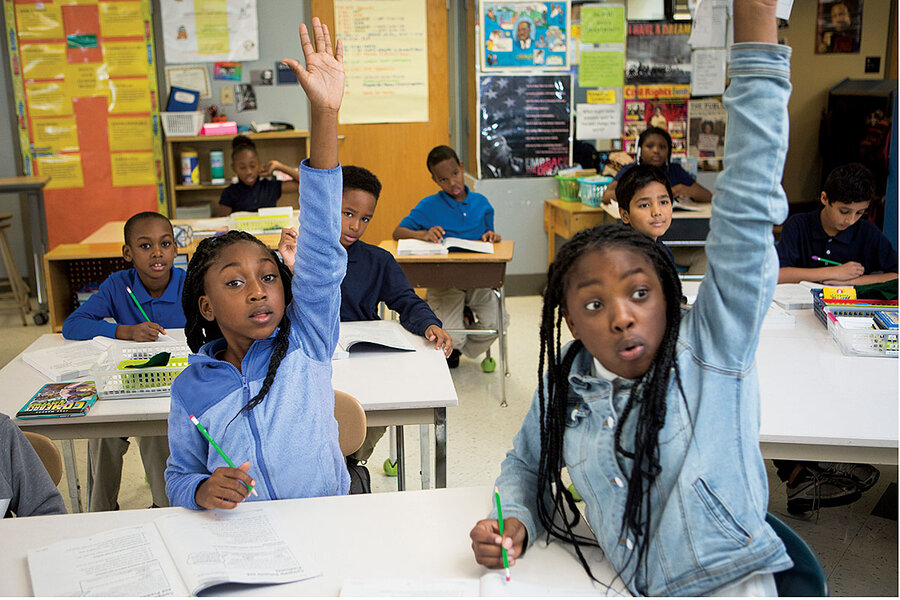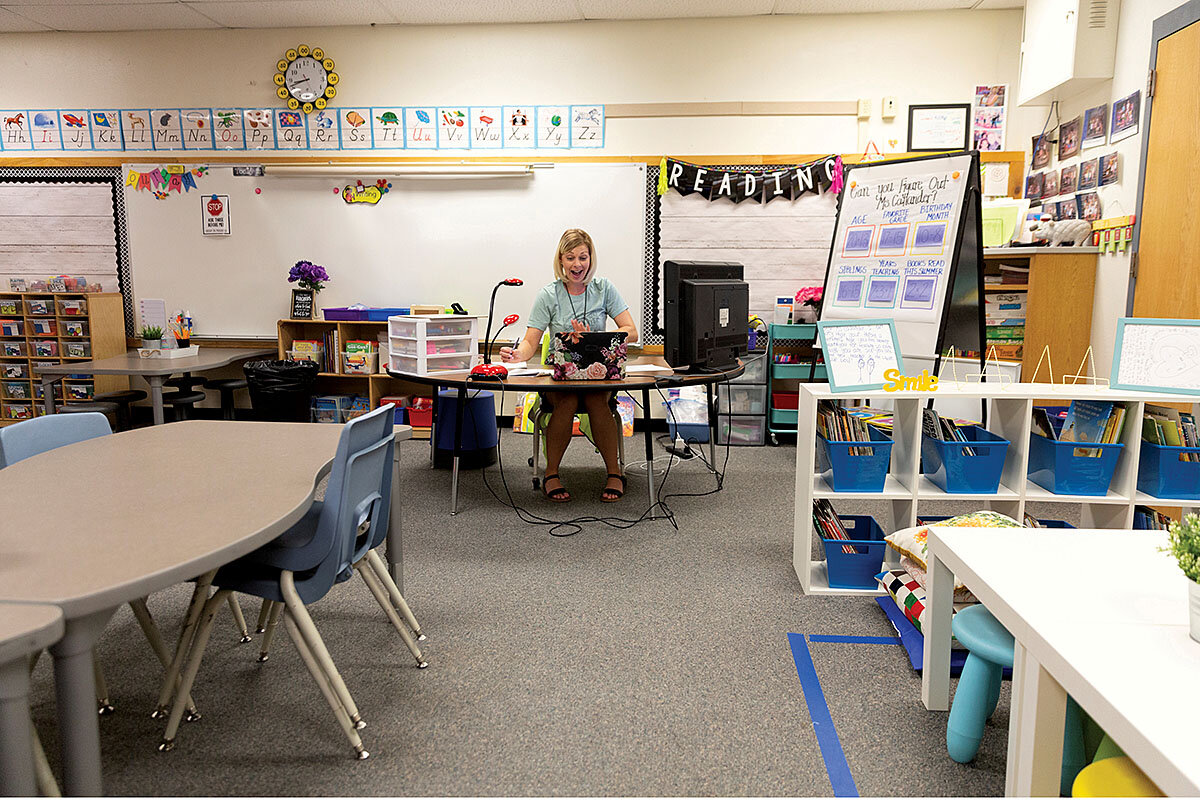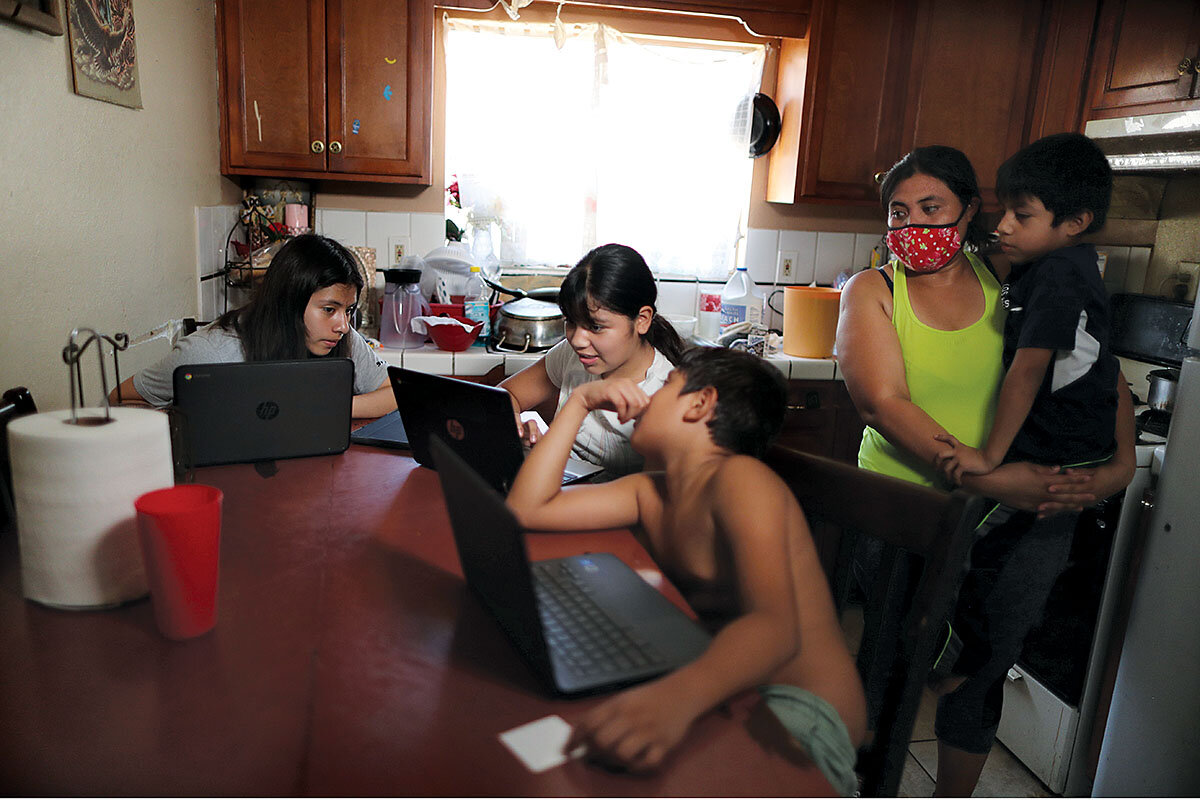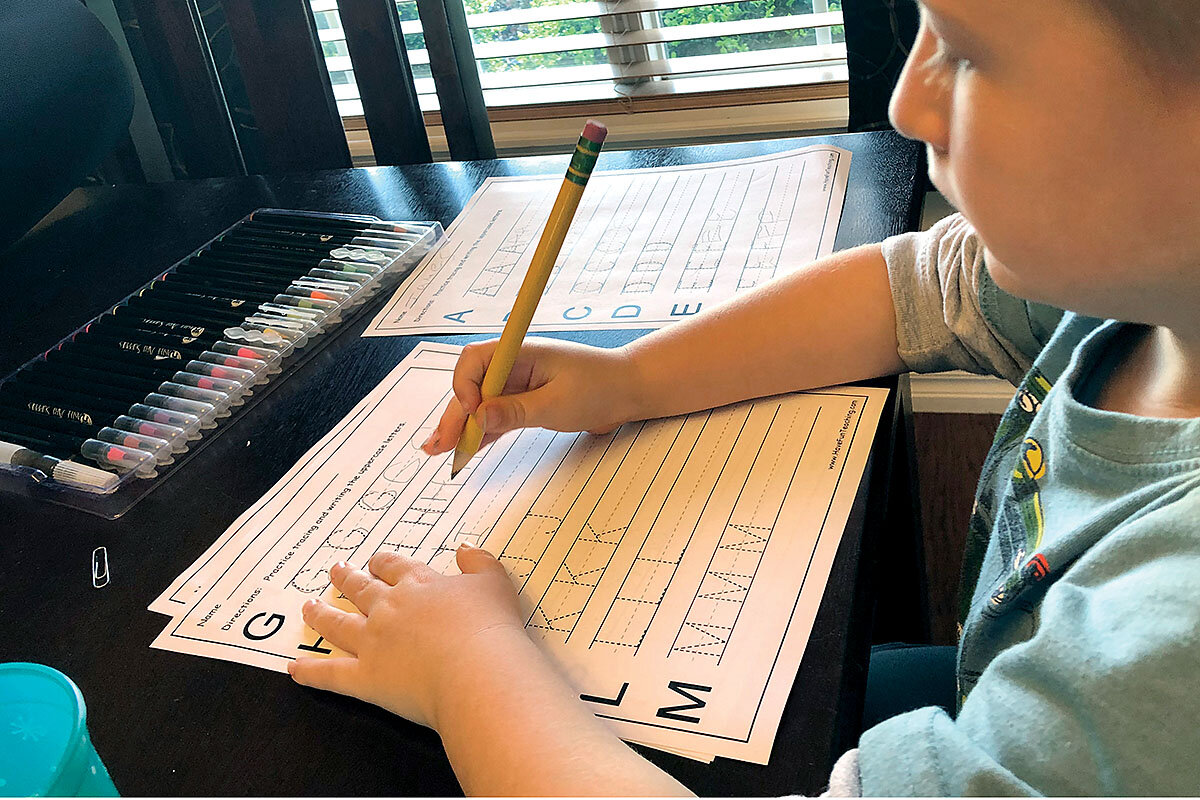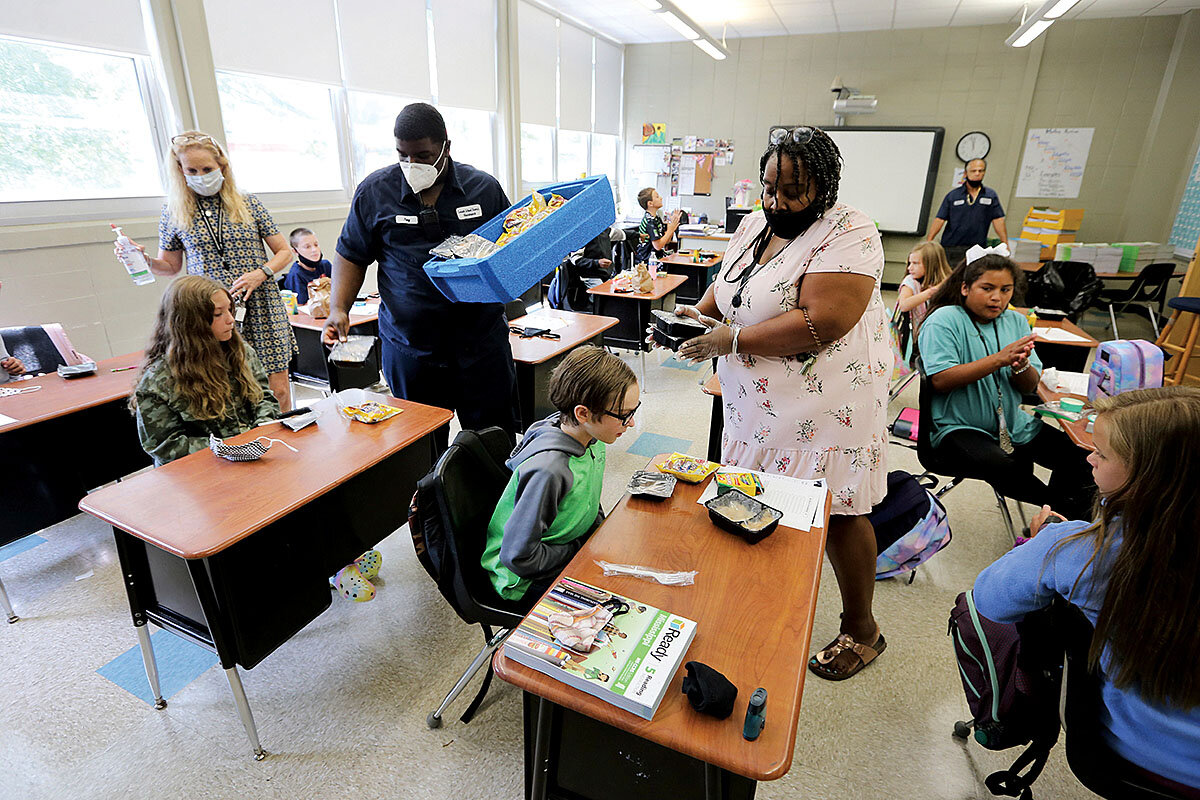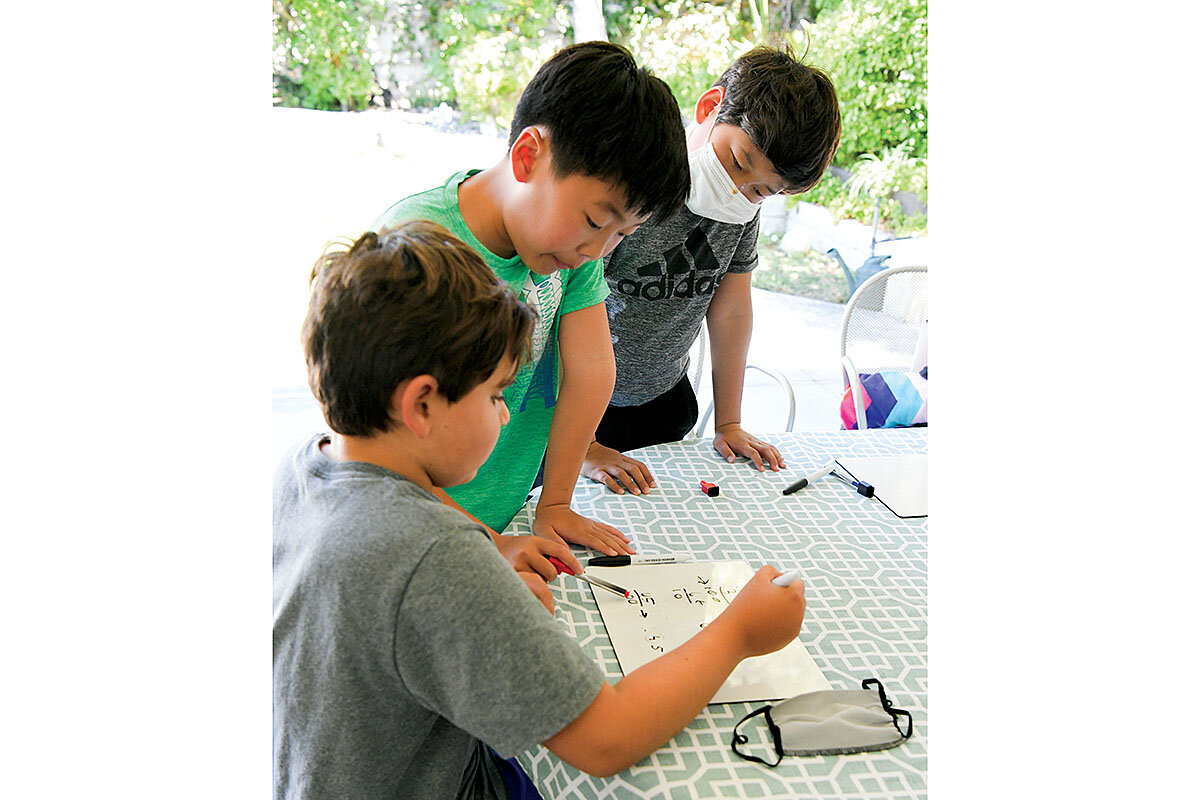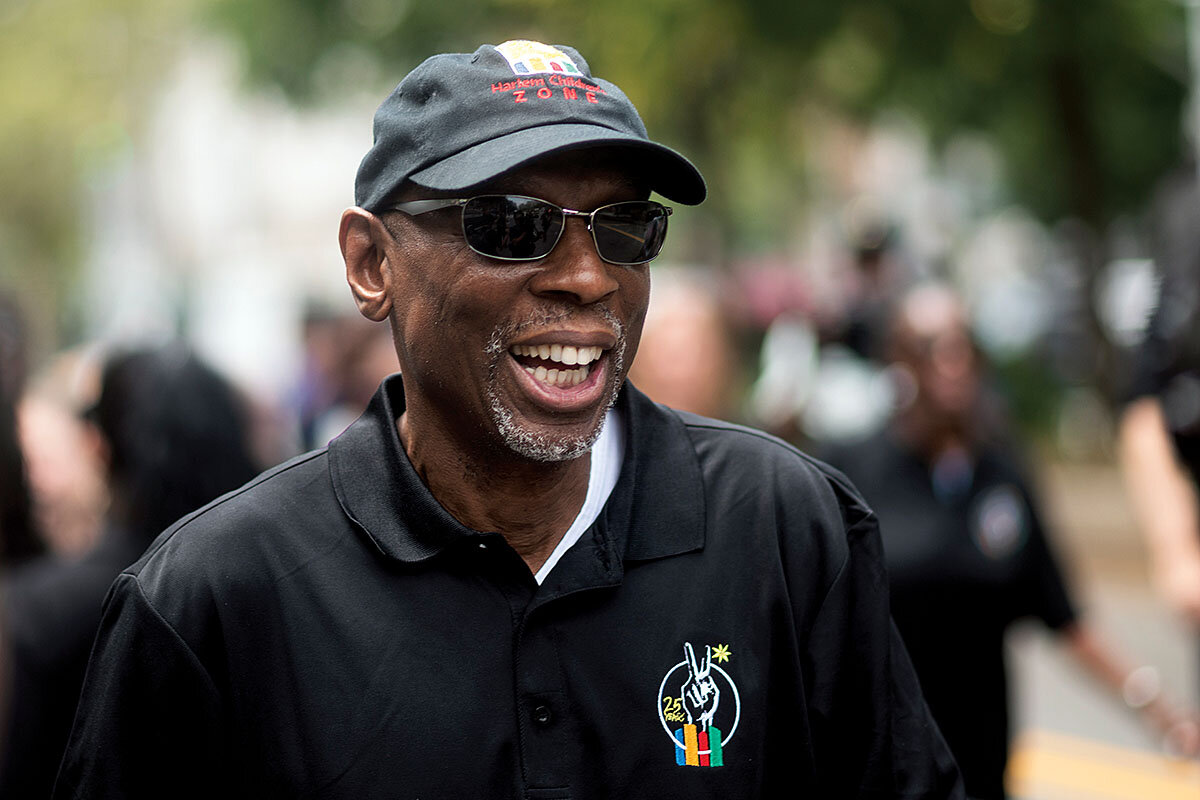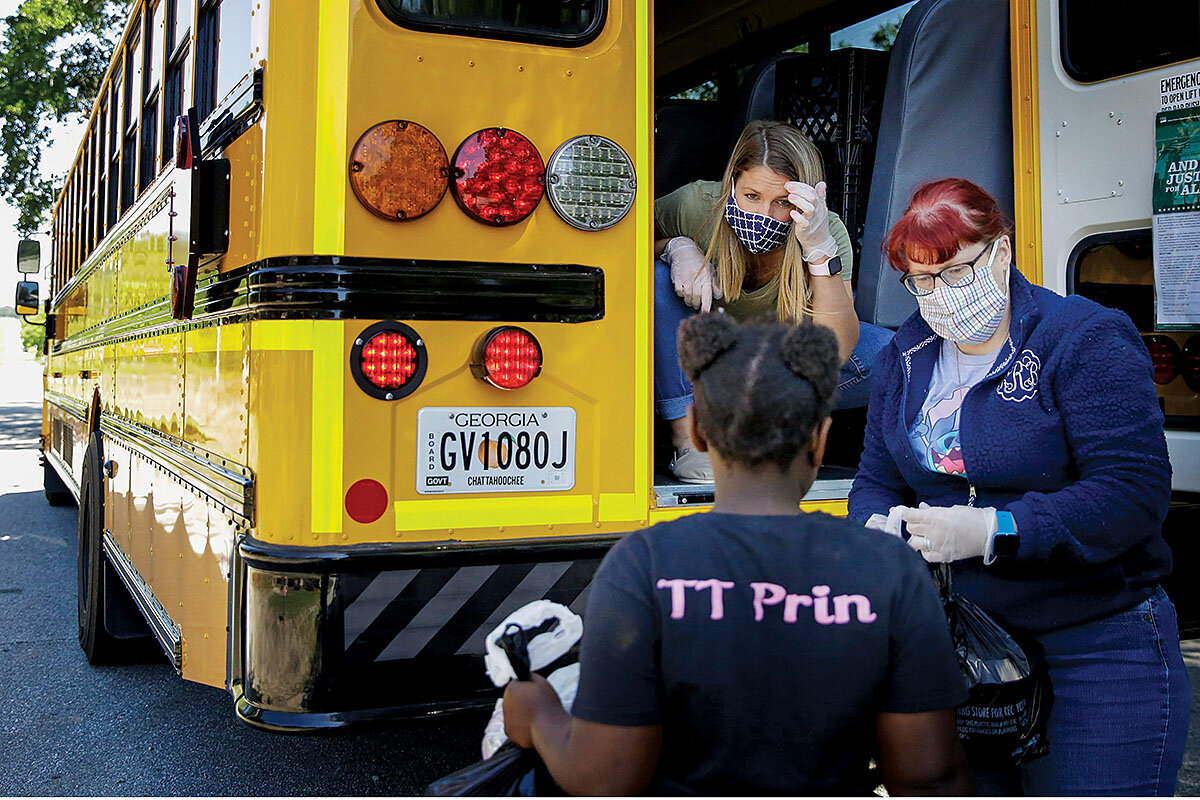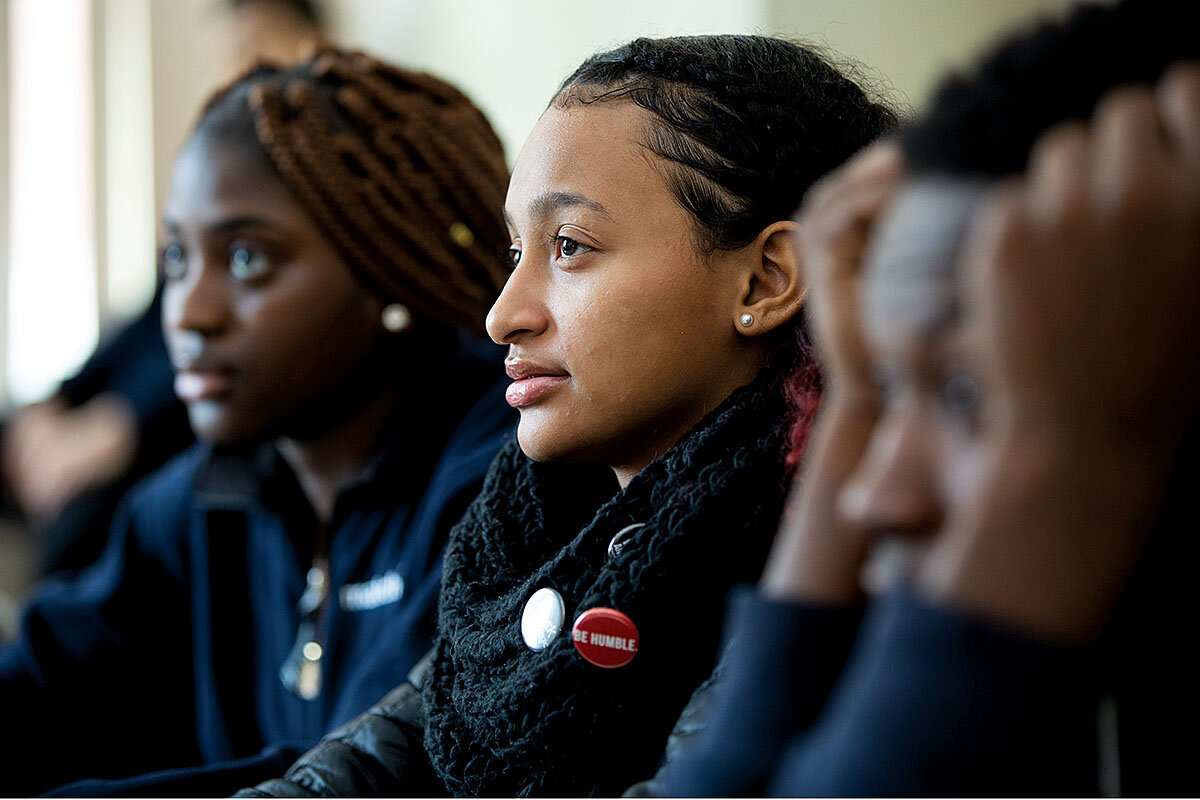How a pandemic exposed – and may help fix – inequalities in education
Loading...
In the early 2010s, Jon Valant, a senior fellow at the Brookings Institution’s Brown Center on Education Policy, began researching Americans’ perception of the “achievement gap,” mainstream lingo for the difference in educational outcomes between historically advantaged and disadvantaged students.
What he found surprised him.
As a scholar of education, he thought it was clear that systemic racism had long impacted the country’s school system. From the days of slavery, when it was illegal to teach Black children, to today, when researchers have found that school districts filled primarily with students of color receive billions less in funding than predominantly white school districts, students of color have faced undue difficulties.
Why We Wrote This
Education faces existential change as a result of the COVID-19 crisis. But the tumult may open the door for innovation, helping schools reduce inequality – through everything from microschools to joy-based learning.
But most Americans, it turned out, did not see it this way. Indeed, according to a study that he released in 2016 with colleague Daniel Newark, most Americans – particularly white Americans – did not believe that discrimination or injustice played a role in the different educational outcomes of white and Black students. They blamed parenting and student motivation instead.
While respondents were interested in closing disparities between wealthier and poorer students, a majority were hesitant to support policies that experts believed would close the Black-white divide. “Most Americans at the time just did not believe that social injustice or discrimination played a role,” recalls Dr. Valant.
This year may be changing that. It may also be opening the door to what some scholars hope could be a once-in-a-lifetime opportunity to revamp one of the most intransigent systems in American life, education; and one of its most intractable problems, inequity.
Recent polling shows a dramatic shift in the way Americans see racial disparity. A majority of white Americans now believe policing is racially biased, according to a recent Associated Press poll, and there is a growing sense among white Americans that racial injustice is a continuing problem in the United States – something that most Black Americans have said for years. At the same time, the COVID-19 pandemic has laid bare the reality that some students simply do not have the same resources as others, whether technological, familial, or institutional. A recent Pearson survey found that 72% of U.S. respondents worried the pandemic would exacerbate inequality at school.
“There are gaps that have always been there that are becoming more visible to a lot of people,” says Dr. Valant.
For decades, educational reformers from all sides of the political spectrum have faced an uphill battle making fundamental changes to the American school system. As John Danner, an entrepreneur who focuses on equity in education, puts it, public schools are a “free monopoly,” a system that is both resilient and resistant to uncomfortable disruptions or innovations.
“But will the next two years of COVID allow some cracks to form in that structure?” he asks. “I think to some extent yes.”
The big question, he and others say, is how to make the most of this opportunity.
With this in mind, the Monitor reached out to experts across the country to ask for their ideas of how to rethink education to create a more equitable future for America’s students – from the bold and creative to the mundane but essential.
Below are five solutions that emerged from those conversations. They are ideas to ponder during a pandemic-induced disruption that David Kirkland, professor of English and urban education at New York University and the executive director of NYU’s Metropolitan Center for Research on Equity and the Transformation of Schools, describes as an “incredibly crucial intermission.”
“How can we focus not only on what the disease has taken from us but what it’s given us?” asks Dr. Kirkland. “The best way to predict the future is to invent it.”
Tech, yes, but better
America’s uneven experience with remote online-based learning this year has made many people shy away from the idea of a tech-based education future. Parents are exhausted, students are bored, and America’s digital divide, with Black people and Hispanics far less likely than white people to own a computer or have access to high-speed internet, threatens to exacerbate learning inequities.
But many involved in cutting-edge educational technology say there is still huge potential in online learning to both improve education and reduce inequalities.
“It was difficult to watch during the spring how we were not doing it right,” says Jan Plass, professor of digital media and learning sciences at New York University, during a recent webinar about the future of education. “Emergency remote learning was nowhere near what technology can accomplish.”
Done well, Dr. Plass says, technology can engage students by allowing them to pursue their own interests, regardless of the resources or capabilities of their particular school. Through augmented and virtual reality, gaming, and other formats, students can connect to larger networks and delve into interest-driven activities scholars know motivate children to learn.
“The right technology can give you access to the vast amount of information that’s available,” he says. “It gives you access to a wider world.”
This sort of technology can disrupt what he sees as an outdated model of “sitting in a room full of chairs with someone standing at the front talking to you.” And it can be available to students with the technology they have. While the Pew Research Center found a significant racial divide in broadband access, it also found that Black people and white people are equally likely to own smartphones.
Technology can also boost equality when it comes to educational opportunities outside of school, says Amir Nathoo, co-founder of Outschool, a burgeoning marketplace of online classes and camps.
“Supplemental education before was the reserve of the wealthy, people who could afford private enrichment programs,” he says. “With small group online classes, you’re getting much lower price points.”
At Outschool, weekslong lessons for everything from piano basics to video game design cost as little as $10 an hour. Outschool has also pledged $3 million to provide financial assistance to families. Because the classes are online, Mr. Nathoo says, they connect children of different socioeconomic and racial backgrounds more regularly than in-person schools, which tend to cater to students who are demographically similar.
“I’m not advocating that anyone learn online every day, all day,” Mr. Nathoo says. “The future of education is going to be hybrid. Teachers, parents, and kids will use a combination of in-person and online resources. The mix will depend on the subject, the kid, the particular availability of resources.”
Forget grade school
If you start with the idea that education in the future could be hybrid, then it doesn’t take long to question some of the long-standing structural aspects of school itself.
Why are children grouped by age? Why divide schooling into elementary, middle, and high school? And what about the calendar – why should children go to school when they do?
“Parents for the first time are getting a front-row seat into schooling and are asking questions they haven’t asked before,” says Michael Horn, co-founder of the Clayton Christensen Institute for Disruptive Innovation and co-author of “Disrupting Class: How Disruptive Innovation Will Change the Way the World Learns.”
Take child care, he says. Perhaps more clearly now than ever, working parents who have struggled through remote learning recognize that schools play a significant role in child care. But even in the best of times, Mr. Horn points out, schools are not particularly well designed for that.
“I’m not sure a lot of two-working-parent families want child care from 8 a.m. to 2 p.m. and not during the summer,” he says. “What are the opportunities to create a much better set of coverage for families that is more flexible?”
This is an equity issue, says Elena Silva, director of Pre-K-12 for the education policy program at New America, because parents with more resources can compensate for the inadequacies of school structure. They have jobs that allow them flexibility to be at home in the afternoon, or they can enroll their children in after-school programs.
They are also able to offset the ways that the current school structure, set up for a host of historical and institutional reasons unrelated to children’s needs, disconnects with childhood development.
For instance, studies question the traditional elementary-middle-high school format. Rather than grades one through five being treated as a cohesive group, she explains, it would make more educational sense to focus on birth through third grade, which experts see as a unique developmental phase. At the same time, high schools typically offer the same structure for ninth grade through 12th grade. But during those final two years of school, adolescents are ready to embrace far more independence – and responsibility. And middle school? There is a reason it seems such a mess, she says, and it’s not just because of issues surrounding puberty.
“Nobody ever sat down to say, ‘How should we educate a child from birth to age 25?’” she says. “The weaknesses in the system ... are made up for in households that have a lot of resources.”
Changing the calendar could help with learning loss. “Every single summer some kids fall behind,” Dr. Silva notes. “Other kids gain. They’re going on trips and they’re going to summer camp and they’re having experiences and exposure. It’s covering for those weaknesses in the school system so you don’t see them.”
Some organizations are already trying to tackle this problem. Sora Schools, an education startup based in Atlanta, offers a virtual learning-based high school that adjusts its model as students get older. Rather than classes, students pick among small group “learning expeditions” tailored to match their development, says co-founder Garrett Smiley. Mr. Smiley started Sora after running a nonprofit to teach financial literacy to children in foster care. It became clear to him, he says, that traditional education wasn’t working.
“The kids who were entirely dependent on the system are just being failed,” he says. “We have to fix the system itself. That’s what Sora is doing. We are trying to do a full-fledged replacement that is more equitable and also offers better education.”
Rise of the microschool
Another way to make education more equitable, some experts say, is to look small.
During the pandemic, a growing number of families have banded together to create “pods,” or “microschools” – basically small learning groups led by a private instructor. Critics say this is inequitable: Pods allow wealthy parents to bypass imperfect remote learning while lower-income and students of color languish.
But many who have been involved in the microschool movement for years say that these small, alternative learning arrangements have the ability to create more equity.
Kelly Smith, founder and chief executive officer of Prenda, a company that helps run microschools, says it is a misconception that only white or wealthy parents are involved in creating alternative educational opportunities for their children. Equity, he says, is central to Prenda’s model. The company has partnered with the Black Mothers Forum of Phoenix to bring microschools into primarily Black and lower-income neighborhoods, and it has brought a microschool to the San Carlos Apache Indian Reservation in Arizona.
“Our goal is not to help the rich get richer,” Mr. Smith says.
In Prenda’s microschools, there is a “learning guide” who organizes students’ academics. This could be a student’s parent or another trusted adult in the community. That person is not responsible for teaching all subjects, but coordinates students’ learning, making use of both online and community offerings. This model allows for more investment and ownership on the part of parents who may otherwise feel marginalized by school systems.
It also is easier to recognize and avoid the sort of baked-in racism that happens regularly in larger school districts, experts say, from the way school administrators interact with Black parents to the well-documented disparities in the disciplining of Black and white students.
“Schools are such complex ecosystems. The way they are designed right now, it’s so hard to get anything but incremental progress,” says Michael Finnegan, founder and CEO of QuantumCamp, a science camp and educational program that grew out of Dr. Finnegan’s work with underserved youth in Oakland, California.
Focus outside of school
As schools closed in response to the pandemic this year, it became increasingly clear just how many services they provided to children and families beyond education. There was child care, for sure. But there was also food, with some 20 million children across the country receiving free lunch at school. Mental health counseling is big, too. And child protection services.
“Everyone is worried that someone is going to go hungry because schools aren’t going to provide free lunch,” says Geoffrey Canada, founder of the Harlem Children’s Zone, a renowned educational and neighborhood renewal program in New York. “America should just stop right there and say, ‘How is it that we have so many students who cannot afford to eat?’”
When he began running the Harlem Children’s Zone in 1990, Mr. Canada realized quickly that there was no way to separate school from the rest of children’s lives. Everything about their experiences – where they lived, what was happening with their family, how much violence took place on their street – impacted what happened in the classroom.
“Traditionally, we have separated education from the rest of the environment. ... But there is no evidence at all that for the most disadvantaged students in this country that works,” Mr. Canada says.
Indeed, to Mr. Danner, the educational entrepreneur, it doesn’t work. He notes how in Palo Alto, California, considered one of the best public school systems in the country, lower-income students attending from other districts do not achieve better test scores than in their home schools.
“We look at the data and know it’s not working,” says Mr. Danner. “But we have a lot of loyalty to this system – like it’s this democratic equalizer. ... We’ve all told ourselves a story that if we can just make the system work everything will be good. But, in fact, the system works for the people who have the most political voice in the system.”
What works for students of color, whose communities often lack political or financial power, is wraparound investment, says Kwame Owusu-Kesse,Mr. Canada’s successor.
This is what happens at the Harlem Children’s Zone. The program addresses the needs of the entire community, starting with The Baby College, a parenting and early childhood education course, and continuing through to college, jobs, and mentoring programs and wellness initiatives. The nonprofit runs charter schools but also supports public school students; it uses intense data metrics to measure outcomes and adjust its interventions. What started on one Harlem block has expanded over 30 years into one of the most successful and well-documented experiments in urban education.
Critics have argued that the model would be too expensive to replicate across the country. And less well-funded versions of the program have not had equal success.
But this, Mr. Owusu-Kesse says, is a matter of priorities. The organization is calling for a $100 billion investment in the 100 most disadvantaged neighborhoods in America. Over 10 years, it wants each community to invest $1 billion in education, health care, mental health, after-school programming, mentorship efforts, wellness, and various other initiatives. It’s a huge amount of money, Mr. Canada and Mr. Owusu-Kesse acknowledge, but not compared to costs of incarceration, treating poor health, lost economic revenue, and policing.
“The question of investment is about breaking mental models,” says Mr. Owusu-Kesse. “COVID has shed a bright light on this. We need to reprioritize what we are putting money on.”
Brookings Institution researchers found in 2016 that white families had on average 10 times the wealth of Black families. Dr. Valant of Brookings says that “baby bonds,” a proposal that would give every child at birth a bank account, funded in reverse proportion to a family’s wealth, could help mediate this inequality.
“If we were really able to target and address wealth gaps, you close the gaps in resources when it comes to tutoring, digital divides, pods, all sorts of other things that cost money. ... When you invest more, kids perform better,” Dr. Valant says.
Joy-based learning
There is a question, though, at the base of all of this work. How should students – particularly students of color – experience education? What does it mean to go to school? What is the purpose of learning?
It’s an area that Dr. Kirkland, of NYU, has been pondering a lot recently. As tough as this pandemic has been for families and schools, he is conscious that, for the first time, many children have had the opportunity to see what it’s like to not walk through metal detectors every day. It’s the first time that no students have been suspended and the first time they haven’t gotten in trouble with teachers or school police.
The question he’s been asking, he says, is “what does a joy-based education look like?”
It’s an issue on the minds of many education disrupters. “You have a system that’s built on the opposite of what we know motivates people,” says Mr. Horn of the Clayton Christensen Institute. “There are very few opportunities to feel successful in it; there are very few opportunities to tackle the problems that are interesting to the students themselves; there are very few opportunities to make learning joyful. It’s why every kid starts off excited in kindergarten, and they get to high school and the word they use about school is ‘boring.’”
The belief in educational joy is why Ryan Delk helped create Primer, an online-based home-schooling network scheduled to launch this year. Mr. Delk remembers how his parents decided not to send him to public school in Florida, concluding that it was better for his father to work three jobs for a time and his mother to teach him at home rather than send him to their struggling local school district. Today he sees it as “one of the most incredible gifts that anyone has given me. My parents’ whole orientation was ‘we want you to love learning.’”
Primer helps parents work through the bureaucracy of home schooling, and then connect to experts and the community. Mr. Delk says he has seen growing interest among parents of color. The National Home Education Research Institute says Black students in 2015 made up the fastest-growing segment of home-schooled children.
“Giving parents more options is a good way to increase equity,” he says.
But there also should be joy in traditional schools, most scholars agree. And this is not a straightforward proposition, nor is it apolitical.
In many ways, says Dr. Kirkland, Black children have experienced school as a hostile environment – an institution that is about control and regulation, not expression or pleasure. Joy expressed by Black students has traditionally been viewed with suspicion, he says. Think, for instance, of a group of Black teens laughing loudly together. It often prompts a different institutional reaction from that toward a group of white teens enjoying each other’s company.
“When we see Black and brown bodies in joyful moments there is a collective judgment,” Dr. Kirkland says. “There is a narrative about deviance.”
So it is perhaps unsurprising, he says, that educational institutions catering to students of color have been constructed – consciously or unconsciously – to eliminate joy.
Dr. Kirkland tells the story of a private school on 33rd Street, not terribly far from his work, that serves primarily white and financially privileged students. It has great facilities. The children learn by playing. They have toys and equipment.
“They have created a setting where they can love the kids,” he says.
Two blocks north, there is a public school, with mainly disadvantaged students of color. “They go through metal detectors. They’re marching in single-file lines. There’s no love of them. It’s about obedience. This is the type of school we have created for Black and brown students.
“We have to radically change education.”
Editor’s note: As a public service, we have removed our paywall for all pandemic-related stories.




